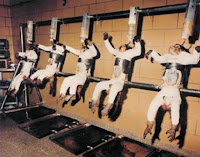Week 2: Math + Art
This week we
learned about how mathematics and art have such strong ties, since decades ago.
In 1316, we see Duccio paint scenes utilizing three dimension. I never knew how
far back math and art have gone back. I also thought it was very interesting to
learn about the two different perspectives, one being artificial, and the other
natural. Looking at paintings from the different time eras it's interesting to
see the different ways artists were able to utilize mathematics or not.
Throughout Professors Vesna's lecture's she mainly focused on artists and their paintings throughout history. With more research I have found other forms of art that heavily rely on math. In our reading a part that really stuck with me, Abbott wrote, "Imagine a vast sheet of paper on which straight Lines, Triangles, Squares, Pentagons, Hexagons, and other figures, instead of remaining fixed in their places, move freely about, on or in the surface, but without the power of rising above or sinking below it, very much like shadows—only hard with luminous edges". I'm able to connect this quote to my research of origami art. The art of turning a flat piece of paper into a three dimensional rose, blows my mind. Another example I found was an amazing piece of art that consisted of mirrors placed in different positions to create a masterpiece. In the description it claims, “The complex perspectives of the space rendered through the reflections are difficult to decode. Looking up into a Tetrascope from below, a perspective from which the Tetrascopes are very reminiscent of kaleidoscopes, the view is of the seemingly infinite”. Going back to learning about perspectives in our lecture, I thought this was especially important to include.
When thinking of the two cultures, I find it most interesting to me to connect it back to my personal knowledge of dance. Math is seen so often in dance, whether it's the geometric formations a large group can create, or the very physics of a pirouette turn, math and dance have a very tight relationship.
Throughout Professors Vesna's lecture's she mainly focused on artists and their paintings throughout history. With more research I have found other forms of art that heavily rely on math. In our reading a part that really stuck with me, Abbott wrote, "Imagine a vast sheet of paper on which straight Lines, Triangles, Squares, Pentagons, Hexagons, and other figures, instead of remaining fixed in their places, move freely about, on or in the surface, but without the power of rising above or sinking below it, very much like shadows—only hard with luminous edges". I'm able to connect this quote to my research of origami art. The art of turning a flat piece of paper into a three dimensional rose, blows my mind. Another example I found was an amazing piece of art that consisted of mirrors placed in different positions to create a masterpiece. In the description it claims, “The complex perspectives of the space rendered through the reflections are difficult to decode. Looking up into a Tetrascope from below, a perspective from which the Tetrascopes are very reminiscent of kaleidoscopes, the view is of the seemingly infinite”. Going back to learning about perspectives in our lecture, I thought this was especially important to include.
When thinking of the two cultures, I find it most interesting to me to connect it back to my personal knowledge of dance. Math is seen so often in dance, whether it's the geometric formations a large group can create, or the very physics of a pirouette turn, math and dance have a very tight relationship.
Sources and Citations:
Abbott, Edwin A. "Flatland A Romance of Many
Dimensions." Flatland: A Romance of Many Dimensions. N.p.,
n.d. Web. 17 Apr. 2017.
Lang, Robert J. "Robert J. Lang
Origami." Robert J. Lang Origami. N.p., n.d. Web. 17 Apr.
2017.
"Tetrascopes, 2013." ART+COM
Studios | Tetrascopes. N.p., n.d. Web. 17 Apr. 2017.
Averett, Alexis. "How Do You Use Math in
Dance." Prezi.com. N.p., 10 Jan. 2011. Web. 17 Apr. 2017.
Mathematics-pt1-ZeroPerspectiveGoldenMean.mov. Perf. Victoria Vesna. N.p., n.d. Web.
<https://www.youtube.com/watch?v=mMmq5B1LKDg#action=share>.




I really like your perspective of math being used in dance forms. A dance performance recently used active real time face mapping along with face projection to change the appearance of the dancers' faces as the song progresses, which I think is one of the most beautiful ways science and math can be used in dance forms. I also agree with you that the way how light is reflected in sophisticated ways in a tetrascope makes it a mesmerising piece of art.
ReplyDeleteI used the same rose picture in my blog! I think it is very interesting that you made a connection with dance. Because of your blog, I start to wondering the connection between math and dance. Well, definitely both of them require hard work. The infinite is absolutely a art piece. The angles of all the mirrors are related with math calculations.
ReplyDelete